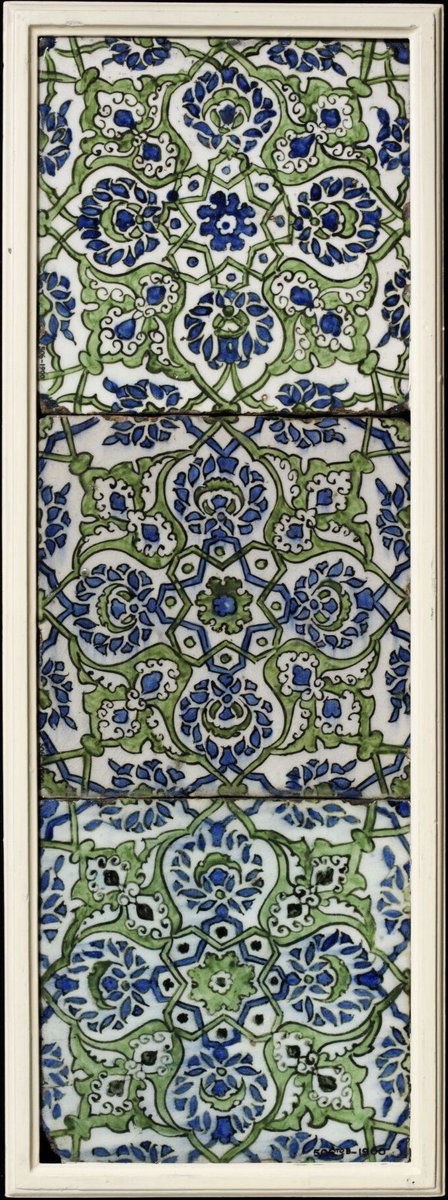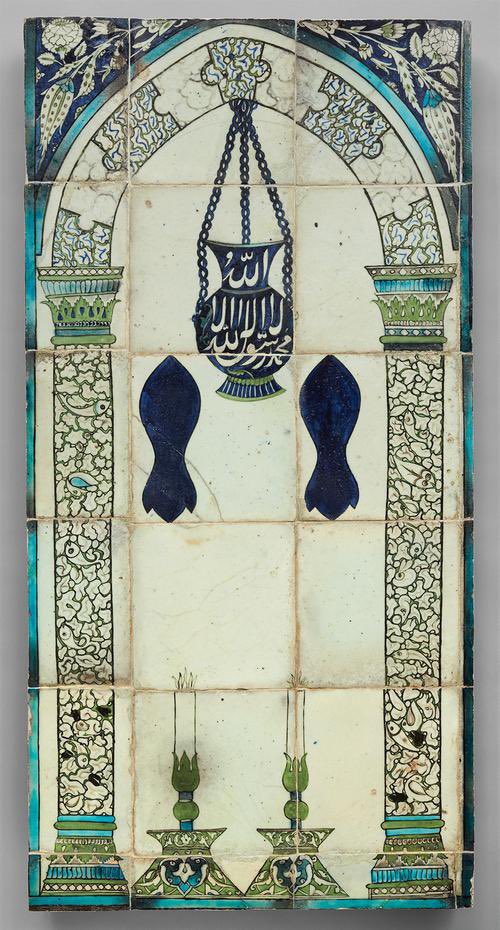
In Ottoman Damascus, ornate tile panels were common decorations, set into the walls of mosques, shrines and other buildings. Many were taken & are now in museums.
A thread on beautiful 17th century fritware tile panels from Damascus, Syria, found in museums across the world...
A thread on beautiful 17th century fritware tile panels from Damascus, Syria, found in museums across the world...

1/ Tile panel Circa 1550 CE - Circa 1699 1699 CE, Ottoman, Damascus, Syria
@FitzMuseum_UK
collection.beta.fitz.ms/id/object/17533
@FitzMuseum_UK
collection.beta.fitz.ms/id/object/17533

2/ A set of forty-eight tiles decorated with vases and cyprus trees amid flowers dates back to 17th century Damascus, Syria, under the Ottoman Empire.
@AshmoleanMuseum
collections.ashmolean.org/object/353424
@AshmoleanMuseum
collections.ashmolean.org/object/353424

3/ Nine tile panel, 17th century, Syria
Similar is in situ in the shrine of Muhly al-Din Ibn al Arabi in the Salahieh quarter of Damascus, built in 1518 by Sultan Selim I and restored in the 18th century
@V_and_A
collections.vam.ac.uk/item/O180802/t…
Similar is in situ in the shrine of Muhly al-Din Ibn al Arabi in the Salahieh quarter of Damascus, built in 1518 by Sultan Selim I and restored in the 18th century
@V_and_A
collections.vam.ac.uk/item/O180802/t…

4/ A panel of ten square tiles Circa 1550 CE - Circa 1699 1699 CE, Ottoman, Damascus, Syria
Set in a rectangular ebonised frame made in sections and lobed on top edge.
@FitzMuseum_UK
collection.beta.fitz.ms/id/object/17525
Set in a rectangular ebonised frame made in sections and lobed on top edge.
@FitzMuseum_UK
collection.beta.fitz.ms/id/object/17525

5/ Tile Panel with Floral and Grape Motifs, 15th century, Damascus, Syria.
@hi_shangrila
collection.shangrilahawaii.org/objects/3684/p…
@hi_shangrila
collection.shangrilahawaii.org/objects/3684/p…

6/ Tile panel, 15th c, Damascus Syria
It is so similar in technique, composition, & style to one signed by Ghaibi & still extant in the funerary complex of Ghars al‑Din al‑Tawrizi (d. 1430) in Damascus that it probably came from that building
@metmuseum
metmuseum.org/art/collection…
It is so similar in technique, composition, & style to one signed by Ghaibi & still extant in the funerary complex of Ghars al‑Din al‑Tawrizi (d. 1430) in Damascus that it probably came from that building
@metmuseum
metmuseum.org/art/collection…

8/ Tile panel, 16th century Syria, Damascus.
The Arab Hall, Syrian tile panel, south wall.
Leighton House Museum, Royal Borough of Kensington and Chelsea. @LeightonHouse_
The Arab Hall, Syrian tile panel, south wall.
Leighton House Museum, Royal Borough of Kensington and Chelsea. @LeightonHouse_

9/ Tile panel Circa 1550 CE - Circa 1699 1699 CE, Ottoman, Damascus, Syria.
This panel of tiles has religious subject matter: the Arabic inscriptions name Allah, the Prophet Muhammad, and the four caliphs of the Sunni tradition.
@brooklynmuseum
brooklynmuseum.org/opencollection…
This panel of tiles has religious subject matter: the Arabic inscriptions name Allah, the Prophet Muhammad, and the four caliphs of the Sunni tradition.
@brooklynmuseum
brooklynmuseum.org/opencollection…

10/ Three tile panel, 17th century, Damascus, Syria
The same cartoon or stencil are found in the Salimiye madrasa in Damascus dating from 1566. In the 16th century, Damascus became an important Ottoman provincial capital.
@V_and_A
collections.vam.ac.uk/item/O181162/t…
The same cartoon or stencil are found in the Salimiye madrasa in Damascus dating from 1566. In the 16th century, Damascus became an important Ottoman provincial capital.
@V_and_A
collections.vam.ac.uk/item/O181162/t…

11/ Tile panel Circa 1550 CE - Circa 1699 1699 CE, Ottoman, Damascus Syria
Inscribed with the name 'Ali. Panel represents the interior of a mosque & is inscribed with the names of Allah, Muhammad & the caliphs Abu Bakr, Umar, Uthman & Ali
@britishmuseum
britishmuseum.org/collection/obj…
Inscribed with the name 'Ali. Panel represents the interior of a mosque & is inscribed with the names of Allah, Muhammad & the caliphs Abu Bakr, Umar, Uthman & Ali
@britishmuseum
britishmuseum.org/collection/obj…

12/ Nine tile panel, 17th century, Damascus, Syria
Virtually identical tiles are found in the Darwishiyya Mosque in Damascus, erected in 1571.
@metmuseum
metmuseum.org/art/collection…
Virtually identical tiles are found in the Darwishiyya Mosque in Damascus, erected in 1571.
@metmuseum
metmuseum.org/art/collection…

13/ Eighteen tile panel, 17th century, Damascus, Syria
Panel of 18 tiles belongs to a group of architectural elements known as mihrab panels. This was placed in religious buildings, mostly in mosques, where it indicated the direction of prayer on the qibla wall
@AgaKhanMuseum
Panel of 18 tiles belongs to a group of architectural elements known as mihrab panels. This was placed in religious buildings, mostly in mosques, where it indicated the direction of prayer on the qibla wall
@AgaKhanMuseum

• • •
Missing some Tweet in this thread? You can try to
force a refresh






















